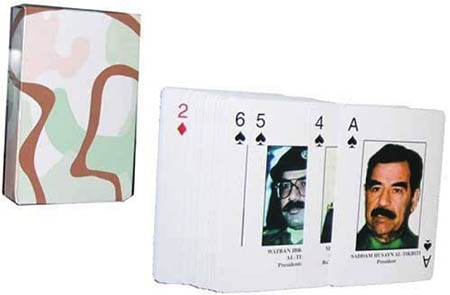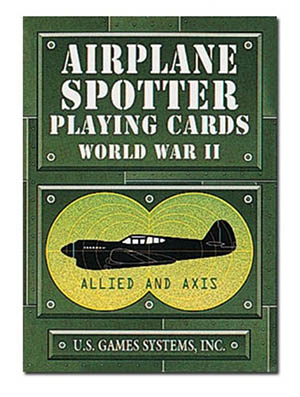
|
| « Articles | History of Playing Cards | Gallery of Playing Cards | Card Games Rules | CONTACT |
Dealing From A Fateful Deck

A set of 2003 Iraqi Most Wanted Cards issued by the U.S. Military.
There are certain methods of card playing that are not only frowned upon but will cast the player in a dim light. Cheaters who deal from the bottom of the deck, or who mark the cards in order to gain an advantage, will forever live with that shame when outed by their fellow players.
As well, there are certain cards that you just don't want to see in your hand, or to be played against you at a key moment. For example, catching the queen of spades in a game of Hearts can be a soul-crushing moment.
However, no deck of cards ever destined someone to a worse fate than to be one of those who were included among the "personality identification playing cards" that were issued by the U.S. government during the 2003 Gulf War with Iraq.
This deck was more commonly referred to as the Iraqi most wanted playing cards. Depicted on the set were key members of Iraqi President Saddam Hussein's government or high-ranking members of the Iraqi Regional Branch of the Arab Socialist Ba'ath Party. Members of Iraq's Revolutionary Command Council. As well, some members of Hussein's family were also included.
To be included in this deck was much worse than taking a bad beat in a poker room at a Las Vegas sportsbook. It was an almost certain death sentence.
To date, 46 of the 52 men who were featured on the cards have either been killed or captured.
Each deck has two Jokers, one showing Iraqi military ranks and the other Arab tribal titles. Saddam Hussein is depicted on the ace of spades. His sons Qusay (clubs) and Uday (hearts) were also featured on aces in the set. Saddam's presidential secretary Abid Hamid Mahmud al-Tikriti was the person on the ace of diamonds.
The Concept

World War II Airplane Spotter Playing Cards. Photo by: National WWII Museum.
Actually, identifying the enemy via a deck of playing cards is something that dates back to the Civil War in U.S. Military history. The cards were developed by DIA specialists who knew about the old American tradition of using playing cards to help troops learn more about the enemy.
Such playing cards have been deployed as far back as the Civil War, Navy Lt. Cmdr. Jim Brooks explained in a 2003 interview with Stars And Stripes. Strategic decks of playing cards were a training tactic in World War II. The Army Air Corps were issued decks printed with the silhouettes of German and Japanese fighter aircraft. The concept was again utilized during the Korean War.
When not in combat, troops often play cards to pass the time. The idea behind the cards was that when these troops regularly saw the shapes and styles of the enemy aircraft, it would make them much easier to distinguish from friendlies in the heat of an air battle, when split-second decisions were required.
With the Iraqi cards, the concept was taken to a different level. The military thought process was that it would familiarize the American soldiers with the upper echelon of Iraqi leadership, the people who were driving the Iraqi war machine.
By ingraining those names, faces and titles of the wanted Iraqis during their card games, the hope was that it would help soldiers and Marines in case they were to run into the wanted individuals in the field.
Collector's Items
The old cards from previous war times are a hot commodity with playing card collectors. Mint condition versions of these ancient cards can fetch hundreds of dollars in a transaction.
Decks of the Iraqi cards are also sought by collectors.
"Everyone wants them," a weary Pentagon official said shortly after their release in April of 2003. "They say, 'Not for me, you understand - for my mother,' or 'my friend,' or 'my cat' or whatever."
However, even though they're of fairly recent vintage, they are still very rare and difficult to find. Only about 200 of the official cards were printed by the military.
"CENTCOM asked for a couple hundred [decks], and we made them in our own print shop and sent an initial shipment out before the war," Brooks said.
Hoyle was commissioned to produce additional sets if needed but Central Command never asked for more cards beyond the original 200 sets, so no more were printed.
"If they had wanted more, we were prepared to have a [commercial] contractor do it for us, but they didn't ask," Brooks said.
In terms of quality, the Iraqi cards are unspectacular. Then again, they weren't meant to be collectible. Their sole purpose was a practical, tactical application.
The cards "are nothing fancy," Brooks explained. "The corners aren't rounded, and the paper stock is the best we had at the time, but these were never meant to be a collector or novelty item. It was just a handy guide to the guys in the field. They're just a tool."
The U.S. military also cautions collectors to be buyer beware if a set is offered for sale on eBay or another form of collecting transaction. Several knockoffs of the actual cards were produced at the time.
The actual cards were never made available to the general public. The news media was only issued PDFs of the cards.
In fact unscrupulous sellers were offering "real" cards that were never produced by the U.S. government, even before the actual cards had been issued and distributed to active-duty soldiers in the combat zone.
|
|
|
|